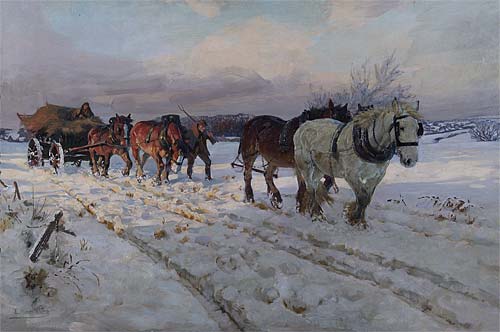Winter’s White Silence
The size and aesthetic power of Winter’s White Silence makes it a very dramatic and memorable piece. It is definitely one of my favourites in the Leamington Art Gallery – as it probably is for almost everyone that visits.
Lucy Kemp-Welch was born in Bournemouth in 1869 and died in 1958. In 1891 she attended Hubert von Herkomer’s art school. He prompted Kemp-Welch to pursue animal painting, in which she became very successful: In 1914 she became President of the Society of Animal Painters and later had a solo exhibition in Bond Street. She was the foremost equestrian painter in her time and is best known for her illustrations in J. M. Dent’s 1915 edition of Black Beauty.
Kemp-Welch was twice nominated for election to the Royal Academy, but she was unsuccessful both times – because she was a woman – and was not accepted in professional artistic circles at the time. However, Winter’s White Silence was exhibited in the Royal Academy in 1924 (the year the painting was finished).
She painted horses obsessively throughout her life. Some of these paintings were so huge that the horses were life-size and so bigger even than the artist. Due to the magnitude, quantity and detail of her work, Kemp-Welch’s paintings have come to constitute a record of dwindling horse breeds: their work and relationship with the landscape. These breeds of horses started to vanish with the rise of industrialization throughout the 19th century. Kemp-Welch reacted against these changes by showing the fundamental role horses played in her contemporary society. She painted horses in a great variety of places, situations and work, suggesting that they had limitless tasks.
Kemp-Welch rode horses herself from a young age. Horse riding gave middle class girls a degree of independence because it allowed them to explore surroundings without a chaperon. With this liberating experience possibly in mind, she painted horses from a woman’s perspective rather than that of a workingman’s.
When Kemp-Welch was painting, the world was in transit for women as well as horses. Being in a period of transition is one of the similarities that link the artist to her subject matter and suggests an affinity between the two. However, women were about to assert themselves, in terms of gaining equal rights to men and more prominent positions within public life, whereas working horses were on the brink of decline in number and power because they were being replaced with machinery.
Kemp-Welch portrays these ideas that horses were fundamental to society, and to her own life as a woman, in a way that positions the horses as heroes. This is conveyed in Winter’s White Silence partly because the viewer’s eye is drawn towards the horses rather than the men. The lighting and bold brush strokes are most dramatic and evident around the horses, making them the focus. Also, the men’s dark clothing sets off the animals, further emphasizing their prominent position. It is the horses that are doing the work and who are shown to be strong. In this way, this painting dignifies, and even immortalizes, the horses and their work. Therefore Kemp-Welch here gives an unusual angle to a common rural, working scene.
Winter’s White Silence is a relatively small work of the artist’s. It was painted between 1923-24. Throughout the 1920s, Kemp-Welch painted a series of snow scenes. These could well have been painted outside: she frequently made sketches from horseback and worked with the horses and labourers to capture their experiences first hand. She loved to paint horses from real life, outside in the open, and would construct makeshift sheds around her canvases so she could leave her work outdoors until the piece was finished.
The many colours used to paint the ‘white’ snow intensify the chilly temperature and frosty season portrayed in the painting. It is a clever device – presenting a snowy scene that at a quick glance appears white. Yet with further pause, there are many colours such as blues, purples, browns and greys that are used to depict the snow. This creates great depth and texture to the natural scene, which gives a realistic and tangible quality to the snow. Being able to define a white horse within a white snowy scene indicates the skill of the artist, and her attention to detail. Kemp-Welch herself once said, “the first things to be noticed about painting a white horse are the small amount of actual white and the warm green colour of the shadows”.
The snow tracks in the foreground lead the viewer’s eye across and into the painting in a way that makes the eye concentrate on the horses and the snow surrounding them. Due to this, it could be argued that the snow and the natural setting is just as fundamental a part of the painting’s themes, form and composition as the animals. So it is very much a painting about the horses, their work and their environment.
Sadly, Kemp-Welch herself declined into relative obscurity as an artist by the end of her life, and so suffered a similar fate to the horses that she loved and painted throughout her artistic career. Though it is pleasing to see that her talent and legacy is being kept alive here and in such a prominent position in the Leamington Art Gallery.

Comments